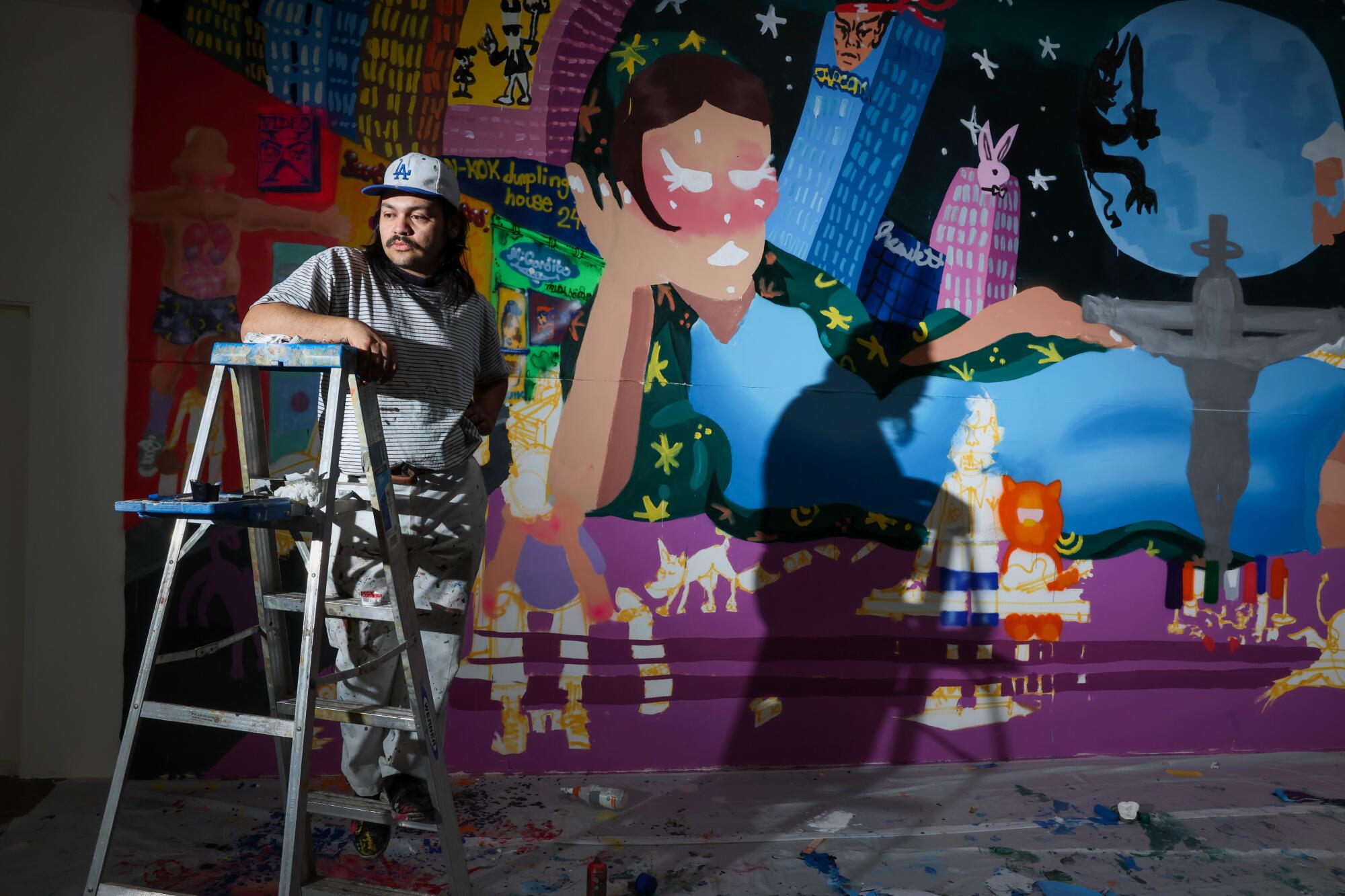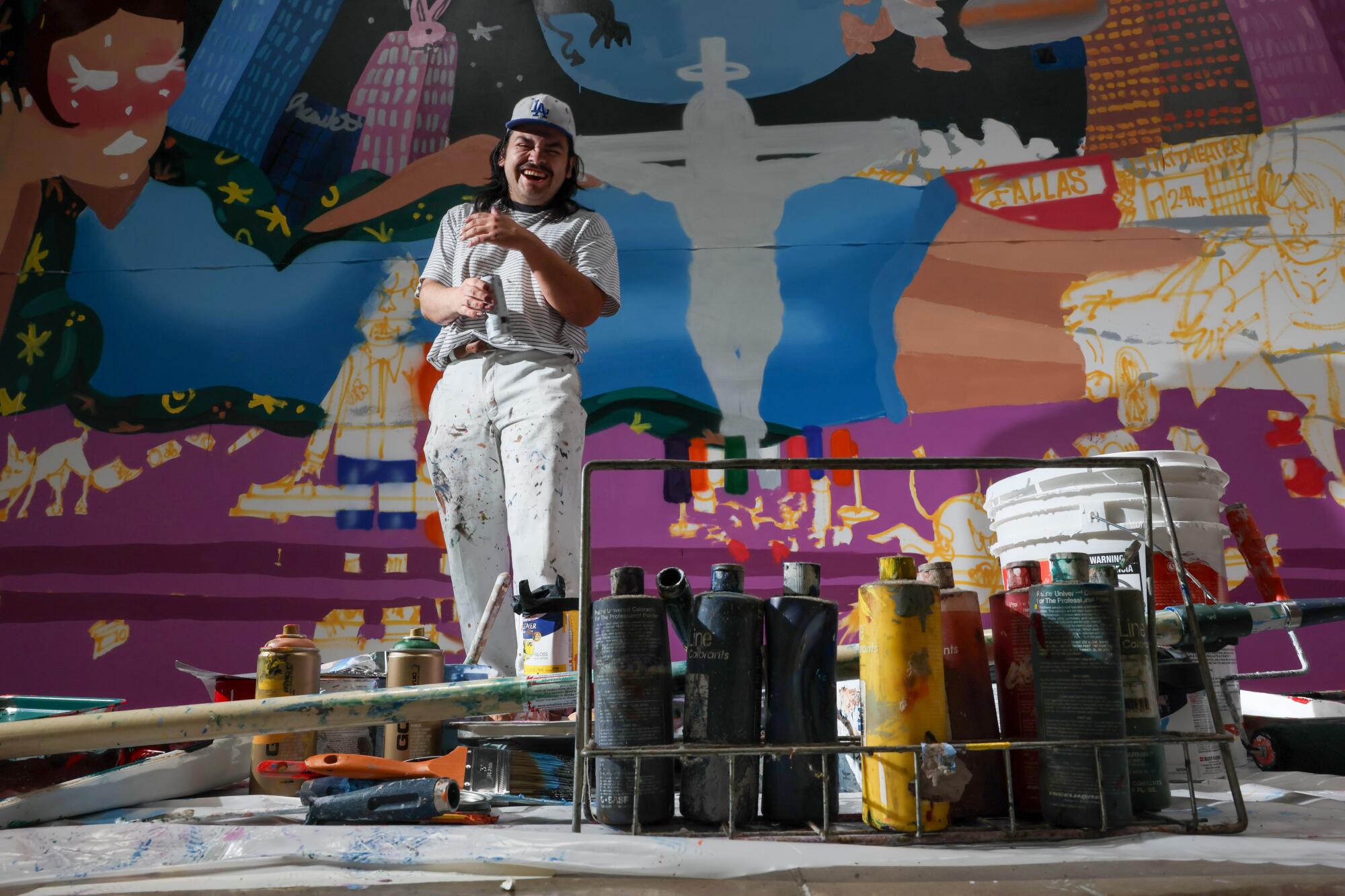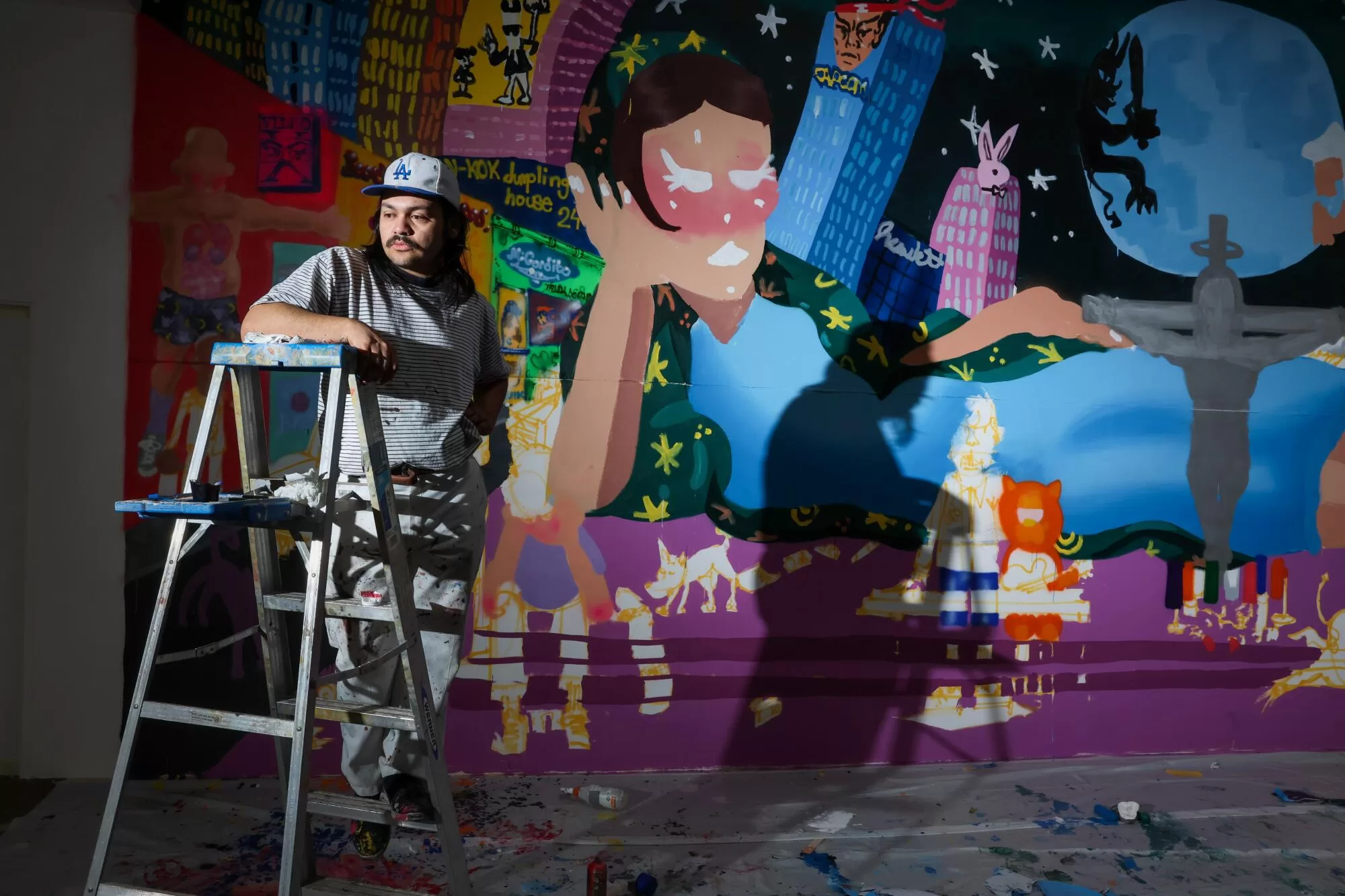“My car got impounded again. I am so sorry I’m late,” said Isaac Psalm Escoto, practically running into Jeffrey Deitch, a contemporary art gallery on Santa Monica Boulevard, energy drink in hand.
It was the second night in a row that his 2006 Scion xA got towed. Escoto, also known by the graffiti alias Sickid, is on a tight deadline to finish the final installment in his first solo exhibition, “Gas Station Dinner.” From the crevice of his ear to the shoelaces on his Converse sneakers, he’s covered entirely in unintentional paint splatters.
The unfinished piece is a 20- by 60-foot canvas wall that mimics a billboard — a size the graffiti artist is well acquainted with. The painting depicts a cityscape that brings together imagery from Escoto’s artistic world of dysfunction. A massive woman is sprawled across the horizon. Her body is framed by warped skyscrapers branded with Cup Noodles, the Playboy Bunny, Western Exterminators’ mascot, Mr. Little, and a blimp reading, “Ice Cube’s a Pimp.” Below the woman, the chaos of the city ensues, including depictions of a car accident, a police chase, a wounded skater, a strip of discount stores and a piano-playing duo. The spray-painted mural is complete with the religious imagery of a crucifix and several battling angels and devils wreaking havoc. All of Escoto’s work is set in this florescent realm of mischief and humor.

Isaac Psalm Escoto pauses in front of one of his works in “Gas Station Dinner.”
(Robert Gauthier / Los Angeles Times)
Inspired by his diet of 7-Eleven hot dogs and taquitos, the 25-year-old painter came upon the name “Gas Station Dinner” as both a joke and a tribute to the people in his life who have stuck by him and his art. The show will be on display until Aug. 10. Walking the line between hyper-realism and hyperbole, his ambiguous reality is inhabited by characters with brown skin, pointy eyeballs, rosy cheeks and rug-burned knees.
Escoto also exhibits a series of canvases featuring characters in acts of misconduct. They are pictured punching the screen of a Taco Bell drive-thru menu, chainsawing an ankle monitor and pointing a gun from behind the counter of a convenience store. No matter how outrageous the characters’ behavior, the artist grounds them in familiar settings such as a messy bedroom, a grocery store and a gas station bathroom.
In the gallery’s back room are a series of smaller-scale works that continue to explore points of view within the context of Escoto’s world. In some paintings, viewers are looking at the world through a microwave door, a fishbowl or a security camera lens.
“I’m inspired a lot by my viewing history of different forms of media. I’ll take something that was super impactful, like ’90s anime that inspired ‘The Matrix’ and ‘Blade Runner.’ Those kinds of things depict cities with a dystopian tone and mix it with culturally rich, diverse and funny imagery,” Escoto said. “I look to Eastern ways of shelling futuristic cities and landscapes and fuse them with my ideas of modern Los Angeles lifestyle.”
The show is a product of Escoto’s first official practice at Tlaloc Studios, where he focused on painting. Before landing a coveted spot at the artist-run studio in South Central L.A., he worked out of a space he created within his mother’s walk-in closet. Over the last three years, Ozzie Juarez, founder of Tlaloc Studios and a fellow artist, has witnessed Escoto transition to bigger-scale works and continuously introduce new techniques.
“When I look at [Escoto’s] paintings, I see an artist that’s enjoying himself while making work,” said Juarez. “The amount of work he puts in tiny sections throughout his paintings is ridiculous. It’s those details that really give you an insight of who Isaac is, what his personality is like and, above all, what it’s like to grow up as Latino in Los Angeles.”
Escoto’s parents emigrated from Mexico and Guatemala. As he reflects on his childhood in East Hollywood, he says the neighborhood helped form his “opinions and viewpoints.”
The works included in “Gas Station Dinner” showcase Escoto’s ability to flesh out his world, where “uncommonality becomes the mundane” and his devious characters are free to run amok.
“It’s a city that’s shaped by other cultures from other countries and by the immigrant lifestyle. That’s kind of how I view my city,” Escoto said. As he says “my city,” he lets out a laugh.
Alongside the inventive cityscape, Escoto’s work is deeply rooted in humor. Making fun of modernity while portraying absurdity is a balance he is well acquainted with. In the painting where a woman aims a gun from behind a convenience store counter, she is surrounded by SpongeBob SquarePants bongs, a wall of sex pills and potato chip bags with rappers’ faces on them.
“It’s not necessarily putting a bow on it or trying to romanticize a delinquency or dysfunction. Instead, I’m just putting out an image saying, ‘This is reality, and it’s not necessarily good or bad,’” said Escoto.
Although this is Escoto’s first major gallery exhibition, Los Angeles is already well acquainted with his work. Before he put his characters on canvases, he spent years painting them all over the city under the guise of Sickid. Instead of tagging his name like other graffiti artists, he is known for creating intricate scenes on billboards, the sides of buildings, bus stops and abandoned storefronts.
From a red devil baby urinating on an obstructed wall in Chinatown to outlandish depictions of luchadores, police officers and angels on an Echo Park billboard, Escoto first found his artistic style as a graffiti-addicted teenager.
He adopted the practice at age 14, spending weeknights sneaking out at all hours to draw his characters around town.
“I was lucky enough to have supportive older siblings who took me to the places that were like gateway drugs to a deeper art experience,” said Escoto.
They first took him to Meltdown Comics, a beloved, now closed comic shop in West Hollywood that specialized in all things comedy and collectibles. Upon entering the storefront, everything changed for him. He equates the experience to entering an art museum for the first time; it was an introduction to a whole new world where he could blend the grit of graffiti with the lively spirit of comics.
“Graffiti is an empowering act because it’s so lawless, and there are consequences to it. So maybe it’s lawful. I don’t know,” Escoto said. “It puts my brain in a place where I put out only images I want to.”
The urgency of graffiti helped him commit to imagery and build confidence as an artist. Saving his “weirder subject matter” for the studio, he found that in the streets he didn’t need to worry about perfection.

Isaac Psalm Escoto is working on a tight deadline for his debut exhibition.
(Robert Gauthier / Los Angeles Times)
“What matters most is what you’re trying to come across in a piece. It’s all about your intention behind it and how are you trying to communicate that,” Escoto adds.
The namesake and owner of the gallery, Jeffrey Deitch, first discovered a Sickid billboard while driving on the 101 Freeway. Allured by the eye-catching imagery, he knew he had to meet the artist.
“Isaac is painting a different kind of L.A. that we all know. It’s those little convenience stores inside gas stations, the rack of products in car washes and the interior of liquor stores,” said Deitch. “He introduces us to that world which we all know but we haven’t seen yet in art. It’s a very interesting thing how he captures this essential aspect of contemporary Los Angeles.”
As Escoto enters his mid-20s, he‘s realized that the true theme of his work is rooted in the struggles that come with adulthood and wanting to return to a childlike place of comfortability.
“A lot of pieces are not biographical but I’m projecting myself into a lot of my subject matter. I live vicariously through my figures, and that’s the basis of the painting,” said Escoto. “I’m depicting the struggles and insecurities of growing up and trying to find yourself through dysfunction.”
Hence the need for gas station dinners.
“As I was sketching the mural with the big extension roller with no ladder, an extreme sense of gratitude came over me, like this is what I would do down the street on a billboard,” Escoto said. “I’m using the same hand, and it’s like I’m looking up at a black billboard, but I’m on the inside of Jeffrey Deitch.”
